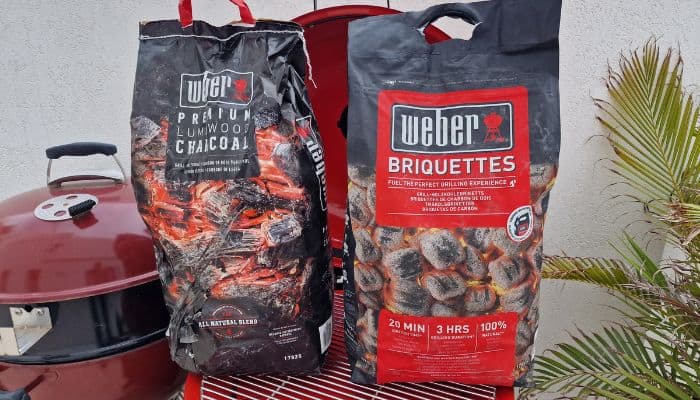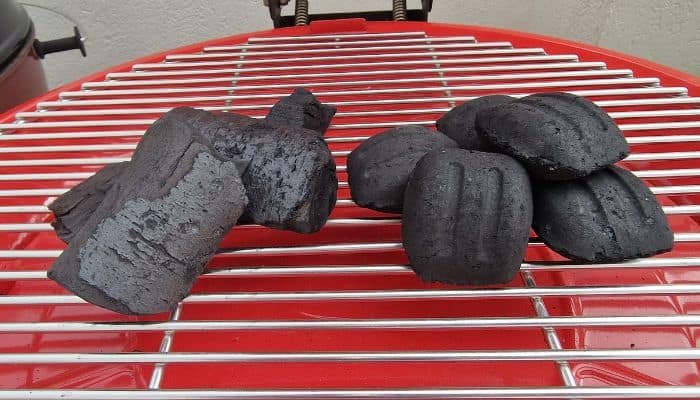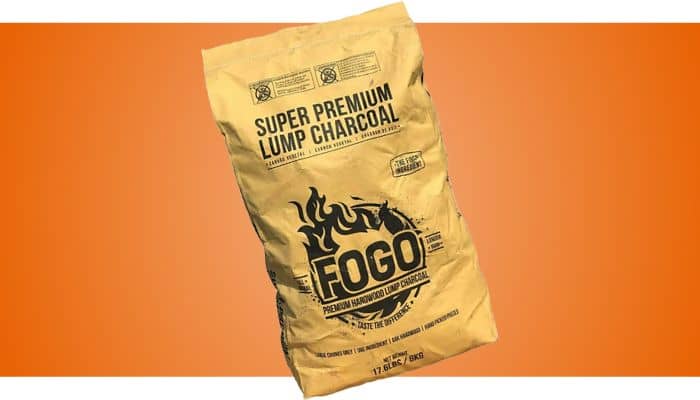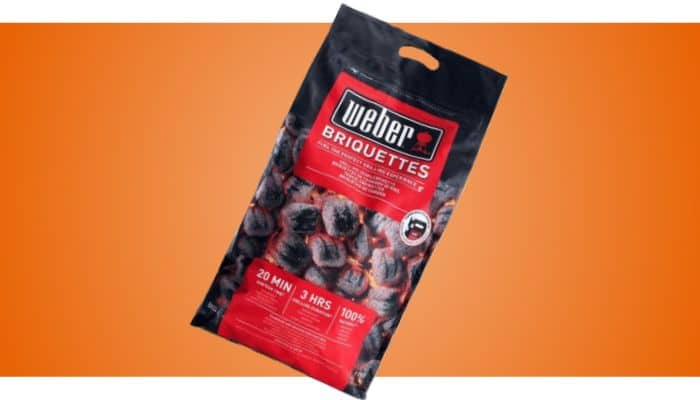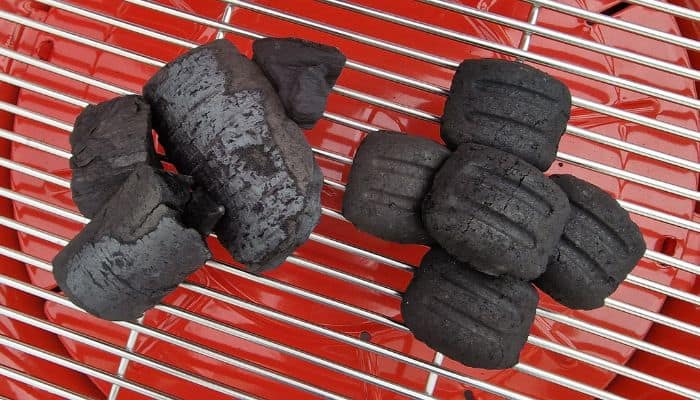There is no more fundamental or hotly contested issue in the world of charcoal grilling than lump charcoal vs. briquettes. Grill experts all over the world will fiercely defend their choice because it serves as the foundation for everything you grill. There is no simple answer to the question, “Which is the current champion lump charcoal or briquettes” but there are several key fundamentals you need to be aware of in order to make the best decision on which one to buy.
Contents
What is Charcoal?
Strongly heating wood with little oxygen produces charcoal, a light black carbon residue that has been stripped of all water and volatile components.
Pyrolysis, the term for heating wood to a high temperature in a low-oxygen environment, produces basic wood charcoal.
Volatile substances like water, methane, and tar are evaporated into the air during this process. The wood is subsequently made to break down into a number of materials, primarily elemental carbon.
Compared to seasoned wood, the material produced will burn cleaner, longer, and more consistently. Additionally, it weighs about 1/3 to 1/5 as little as it did before the heating process.
Then, this charcoal is transformed into either lump charcoal or briquettes.
What is Lump Charcoal?
Wood fragments are slowly burned in the absence of oxygen until all the wood’s inherent compounds, sap, and moisture are released, creating lump charcoal.
After that, we’re left with less dangerous charcoal lump that has many positive features. It is essentially just carbon and burns hotter, and ignites quicker than briquettes.
If your grill has adjustable air vents, you are able to control the heat level because lump charcoal also reacts to oxygen in the same way as wood would.
It is also one of the cleanest methods to grill because it has no additives or fillers. a fantastic option for cooking steak over coals in a caveman fashion.
Because lump charcoal burns hotter and more quickly than briquettes, it’s important to control the temperature carefully.
Lump Charcoal Benefits
- All natural – Contains no additives
- Simpler temperature control
- Hardly any ash production
- Burns hotter than briquettes
- Lighting rapidly
Lump Charcoal Negatives
- Uneven charcoal bits found in bags can make grilling challenging. Although it is possible to cook using the snake method by cutting the lump into briquette-sized chunks, it also requires a little more work
- Cost more than briquettes
- Quicker burning than briquettes
What are Charcoal Briquettes?
Sawdust and discarded wood are used to make briquettes, which are burned like lump charcoal. Briquettes can be made with additives and filler, unlike lump charcoal which is made entirely of wood.
The major function of the additives is to hold the components together to produce neat, sometimes oblong-squarish blocks that are simpler to stack.
Briquettes do not burn as hot as lump charcoal, although they burn for a longer period of time.
To make starting easier, they are occasionally manufactured using chemicals or other lighter fluids. Due to the chemicals used to make briquettes, you will typically taste what you burn. Most good brands will not have these chemicals.
Many people who cook with briquettes have reported smelling the additives while they cook and occasionally even tasting them in leaner foods like chicken or fish.
However, as long as you stock up on a reliable brand like Weber, B&B, or Kingsford (avoid the easy lighting variety), you shouldn’t be discouraged from using briquettes.
Briquette Benefits
- It keeps the temperature constant
- Less costly than lump charcoal
- Burns longer than charcoal
Briquettes Negatives
- Large production of ash
- Can emit a chemical odor
- Greater time to light
I offer a guide to the best charcoal smokers, the best charcoal grills, and the best portable charcoal grill if you’re trying to decide whether you want to try cooking with charcoal. And you’ll also probably like my charcoal vs gas article.
Lump Charcoal vs Briquettes
In addition to the price you pay, the type and quality of charcoal you use will influence other elements such as burn rate, ash generation, and even the food you cook.
But not all of what you read or hear about lump wood and briquettes is accurate. Some pitmasters will buy whatever is natural and on sale, while others have a bias and will only use one brand of fuel.
I personally choose the least expensive option.
Air Is Charcoal’s Fuel
Whatever its form, oxygen is what fuels a fire. Pitmasters control the temperature in their BBQs by opening and closing the intake and exhaust vents.
Open vents encourage airflow and raise the temperature of the pit. Dampers that are partially closed let in less air, which makes the fire cooler.
Note: If the exhaust damper were completely closed, a buildup of combustion gases would result and oxygen would no longer be able to enter the system. Closing the intake similarly stops oxygen from entering the body. Both lead to the “shutting down” of your charcoal grill.
The type of fuel has absolutely no bearing on this idea. Briquettes are often described as burning “less hot” than lump charcoal in several sources. I have even mentioned it above in this article.
This is a little misleading based on my own experiments and experiences. In almost no cases will your grill’s temperature rise above 750F. And even if it did, neither type of charcoal has any trouble reaching these temperatures. So lump might burn hotter than briquettes if in an open firepit, but within the constraints of a grill where the vents have been designed to restrict airflow, it makes little difference.
Fire Configuration
The temperature of the pit will vary depending on how you arrange your charcoal.
As I previously stated, airflow mostly controls pit temperature. Additionally, charcoal byproducts, primarily ash, can stifle airflow by obstructing it and lowering the temperature of your fire.
On your grill, there are many charcoal setups that can create “zones” of direct and indirect heat. This has an impact on how heat is applied to food.
For instance, most people utilize a two-zone fire when smoking meat on a charcoal grill. A zone produces heat by convection, and a second zone produces radiant heat (above the fire).
The two most popular ways to do this are the “minion method” and the “charcoal snake”. You might even strategically position the charcoal such that it passively self-ignites.
Both will self-ignite regardless of the charcoal type and are then powered by oxygen.
Type of Grill
Typically your charcoal choices remain unchanged and unaffected by the type of grill you use or the type of smoker you use.
But Kamado grills are more compact and have less room for ash leftovers. For this reason, makers of ceramic grills will frequently advise using lump charcoal because it generates significantly less ash. Although briquettes with additives can increase ash production, all-natural briquettes can still function just as well.
Lighting Lump Charcoal and Briquettes
Personally, I steer clear of charcoal that self-ignites or is “match-light” capable. I use charcoal for grilling and smoking, and when I grill, I usually taste the chemical preservative if I use this type of charcoal.
It is true that smoking makes it less noticeable, if at all. But why take the risk when there are other alternatives to lighter fluid, including butane torches, compressed cardboard, paraffin wax, and tumbleweeds!?
My preferred method of lighting charcoal has been to use a charcoal chimney starter. They are inexpensive and make lighting charcoal very simple.
I’ve written a comprehensive guide on how to use a charcoal chimney and have made a video explaining how they operate:
Recommended Lump Charcoal & Briquttes
Businesses that deal in charcoal aren’t just looking to make a quick buck; they’re not glad to trick you with gimmicks or marketing as long as it results in a sale. They are aware that the product must be of sufficient quality for the price at which it is being sold because it is a repeat buy market.
All charcoal businesses will try their best, which typically means any pack of charcoal you buy will be decent. They know it only takes one bad batch for many customers to switch brands. But which kind of charcoal do I suggest?
Fogo Super Premium Lump Charcoal
Fogo is a blend of hardwoods from Central America that have been carefully chosen to produce the largest possible charcoal pieces. Its scent is not overpowering, but it gives whatever you’re cooking a pleasant smoky flavor. Fogo burns hot and provides heat for a very long time. This makes it the perfect lump charcoal for slow smoking or searing. Fogo also doesn’t produce a lot of ash.
If asked to name their preferred type of charcoal, the majority of BBQ enthusiasts will respond with natural hardwood. It is typically made from oak and Maplewood and is one of the purest and most reliable kinds of lump charcoal available.
The Fogo brand is associated with premium BBQ fuel. They always use authentic Central American hardwood, which has given them the ability to produce steady, robust fuel for many years.
Longer burn times and higher temperatures are guaranteed by the size of Fogo’s lump charcoal. The characteristics of this lump wood fuel are ideal for making excellent charcoal.
They sell large pieces of their all-purpose lump charcoal, so even a tiny bit will burn hot for a long period. They also promise that 80% or more of the coal you get in any bag will be at least 4 inches in size.
These larger coals provide a larger surface area to burn and help with good ventilation for temperature management. Fogo fuel is more adaptable since it can be used in Kamado grills, which need high heat levels, due to its high cooking temperature.
Fogo’s coals’ natural hardwood composition gives food a deliciously smoky flavor. This alone serves as proof that natural hardwood lump charcoal is always preferable to briquettes that have additives.
It complements standard BBQ meats like brisket or hamburgers exceptionally well because of its natural smokey flavor. Because the charcoal has a much more natural aroma and flavor, it can also be paired with more delicate foods like fish and vegetables.
Given the high temperatures at which they burn, you would be justified in expecting that the smoke produced by these coals would dominate over white meat or vegetation. Fortunately, this is not the situation.
This lump charcoal can tolerate high temperatures and is easy and quick to light. No messing with lighter fluid or electric starters is required. You can dump them all at once into your charcoal chimney and be ready to go in no time.
Natural hardwood lump charcoal is well known for keeping its smoky aromas for hours on end, therefore Fogo’s charcoal fits the bill nicely. Because each coal is enormous, prolonged heating times are assured.
Fogo charcoal has a smaller environmental impact than other coal fuels because the company has committed to exclusively making it from trees that have already perished.
Weber Briquettes
From the beginning, Weber led the way in BBQ innovation and high-quality goods like George Stephen’s (the company’s creator) Kettle grill. Although there have been numerous rivals who have sought to unseat Weber as the leader, Weber has steadfastly resisted. But does this apply to who produces the best charcoal briquettes?
Similar to all the other high-quality briquettes from other companies, this charcoal briquette is free of additional chemicals. Additionally, because Weber briquettes are a bit larger than those from the majority of other manufacturers, you don’t need as many of them to light your grill. Consequently, fewer are required when filling a charcoal chimney starter.
Because they burn hot for a very long time, Weber briquettes are perfect for grillers who have some experience using charcoal-powered barbecues. These charcoal briquettes are among the best in terms of value. While not the cheapest, these briquettes don’t compromise on consistency or quality.
To minimize your carbon footprint, they also come in packaging that is waterproof, recyclable, and resalable. The only significant drawback is that it can be difficult to acquire Weber briquettes in the US, but if your local store does have these charcoal briquettes, I’d highly recommend picking up a couple of packs.
What to Look for When Buying Lump Charcoal or Briquettes
Although charcoal may seem like a simple product, there are actually a number of considerations. Here, I’ll go through the many charcoal characteristics you should consider when choosing which briquettes or lump charcoal to purchase.
Use of All-Natural Ingredients
Briquettes of charcoal made from wood are first burned to create coal dust. By pressurizing the dust, the resulting briquette is produced. Chemicals are frequently applied to the briquettes to make them easier to light and to extend their burn time.
The Weber briquettes are one of many briquettes that use only natural ingredients at all times. Even though some products may list natural ingredients they might not have been entirely made from them. In order to find a truly organic product, look for certification.
If you are unsure about the features of your briquettes, you can always let them burn a little longer before adding any food to your grill. A large portion of the chemicals used in briquettes are there to aid in lighting. After that, the chemical is burned out. Give yourself up to 30 minutes to wait after lighting the grill before beginning to grill your food. This should guarantee that no chemicals are left behind.
For lump charcoal, you’ll only ever get all-natural products so you’ll not have to check any labels.
Burn Time & Ignition
Two of the most important considerations when buying charcoal are the ignition time and the burn time. When you ignite your charcoal, flames will appear. Wait for the flames to go out before you start grilling. This is the ignition time. The typical ignition period is between 10 and 15 minutes.
The fact that ignition times frequently persist much longer than what is mentioned on the packs is the only drawback. As a result, before cooking, be careful to allow at least 30 minutes for ignition. If not, your food might taste a little strange.
A further factor is the burn time. The burn time measures how long it takes the briquettes to self-extinguish after the ignition time. The charcoal will burn and be usable for this period of time.
Weight and Size
Charcoal is available in a variety of sizes for grilling. At the top of the market, you might find something like Weber Charcoal Briquettes or Fogo Super Premium Lump Charcoal. Charcoal bags normally come in two weights: 20 pounds and 40 pounds.
20 lbs or more make a great package size for summer grilling. There is nothing more frustrating than getting up to grill your preferred cut of meat only to find no charcoal remaining. Keep a large spare bag nearby at all times to avert this catastrophe. Additionally, when you purchase in larger quantities, you typically save money.
Another option is a charcoal package that is single-use. The Kingsford Easy Light Bag is a one-time usage bag. Place the bag in your grill, then light a fire. This is quite useful, especially if you’ve never grilled before or are doing it somewhere other than your house. One, two, or six bags of this commodity are supplied in packages, and purchasing more of it will result in cost savings.
Ash
Even with a fantastic ash vacuum, nobody enjoys cleaning up ash from a grill, or even worse, having ash blow all over their food as they cook. There is no way to prevent ash from being created when burning charcoal. Although there are specific lump charcoal and charcoal briquettes on the market that drastically cut down on ash generation.
The best briquettes won’t have any additional additives or fillers, such as sawdust or wood shavings, as these cause excessive ash to be produced. However, some ash is advantageous because it helps insulate the coals.
Some grills, like porcelain grills, can’t handle a lot of ash, so lump charcoal should be used. On a bigger grill, it will be much easier to deal with the ash.
FAQ on Lump Charcoal or Briquettes
Can you use briquettes and lump charcoal simultaneously?
Yes, you can use both briquettes and lump charcoal together (as well as wood for smoking if you wish).
Some people do this to balance out the advantages and disadvantages of both fuels and believe that utilizing both is an effective approach.
It is best to stack briquettes and lump charcoal on top of one another. In other words, you’re sort of building a stacked fire instead of actually mixing the bags.
Theoretically, lump charcoal burns hotter for a shorter period of time and will ideally raise your temperature while the briquettes serve as the workhorse, gradually and steadily sustaining the fire.
Does the type of BBQ you have influence the type of fuel you need to use?
In terms of cooking, the charcoal setup matters more than the kind of pit you use. Pick briquettes and add wood to the fire to improve the flavor if you’re cooking large secondary and tertiary cuts with the lid on. For maximum results, make sure the fire burns clean and maintains a light blue smoke.
Whether the lid is on or off, lump charcoal is the best choice for hot & fast cooking if you want the best flavor. Since the meat is only heated and smoked for a short time, you want to make sure the flavor has a strong smoky punch. If you wish to boost the flavor, add some wood to the mixture.
Why are briquettes less expensive than lump charcoal?
Lump charcoal is created from complete, little logs, hence the raw materials are more expensive than sawdust from other businesses. It is also made of pure wood, with no fillers or cheaper additives added to bring down the price.
Which type of wood is best?
The kind of wood from which charcoals are created is one of their primary variations. Examples of applewood, oak, maple, and a variety of other types of wood can be found. Every one of these woods produces charcoal with distinctive burning qualities that can significantly alter your grilling experience.
Typically, hardwoods are used to create charcoal. These hardwoods produce thick, long-lasting charcoal that can burn for long periods. For instance, Big K’s Dura charcoal uses only White Quebracho, a very high-density wood that produces charcoal that takes more than three hours to burn. All of the wood in El Cubano charcoal is Marabu. Marabu is a very tough wood that allows you to cook for up to three hours.
How can you minimize charcoal waste after a cook?
Like any cook, you should always make sure the lid is down and sealed when you’re done grilling. As a result, the coals will be put out and the fuel can be used again for a subsequent cook. If you are more thrifty, you’ll be astonished at how many cooks you can get out of a single bag of charcoal.
Is lump charcoal harmful to the planet?
Since lump charcoal is made entirely of carbonized wood, it burns more cleanly than charcoal that contains many additives. Naturally, this is crucial when cooking because you want something that emits a flavorful smoke without contaminating your meat with overpowering, bitter, or unpleasant flavors from other ingredients. Some products, like the Kamado Big Block lump charcoal, can even be used more than once, resulting in less waste being produced.
Sustainability plays a key role in a lump charcoal’s environmental impact. As was already noted, numerous businesses make their lump charcoal utilizing sustainable methods. Utilizing readily renewable resources and selective harvesting are a couple of them. For instance, Original Natural Charcoal’s blend of cherry, apple, and oak is made only from clipped limbs and felled trees.
Final Thoughts
There are numerous benefits to using briquettes as well as lump wood charcoal. Which one should you pick? The decision ultimately depends on your preferences and the kind of cooking you wish to accomplish.
Finally, I want to encourage everyone to relax and have fun. Regardless of whether you use briquettes or lump wood charcoal, the planet will continue to revolve. Break out of your comfort zone and experiment with a different fuel because, in my opinion, a great BBQ is about experimenting and enjoying the experience.
